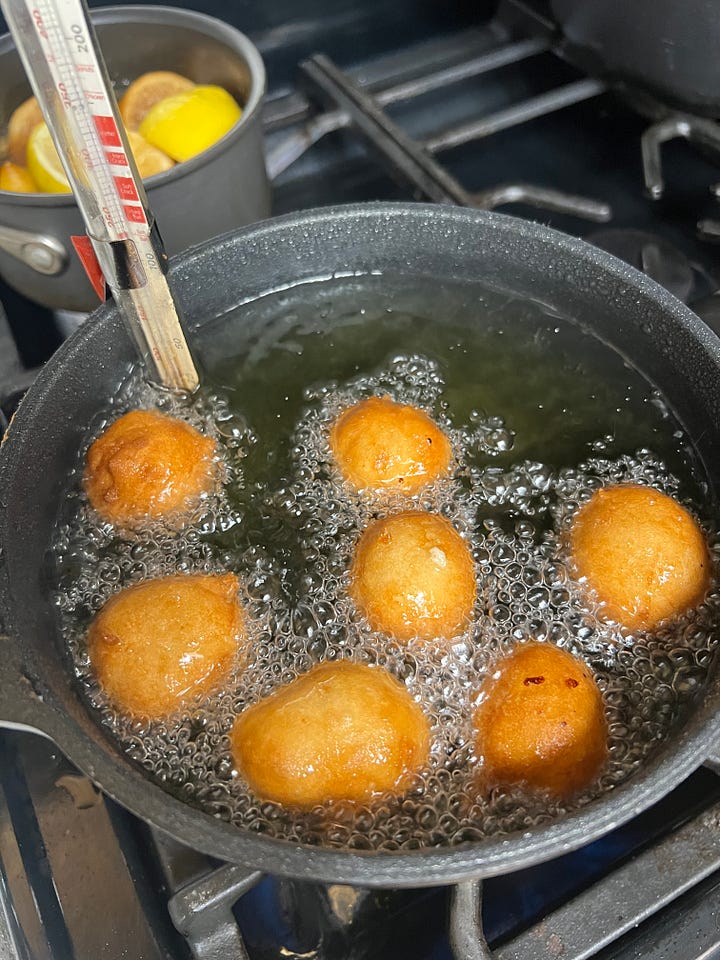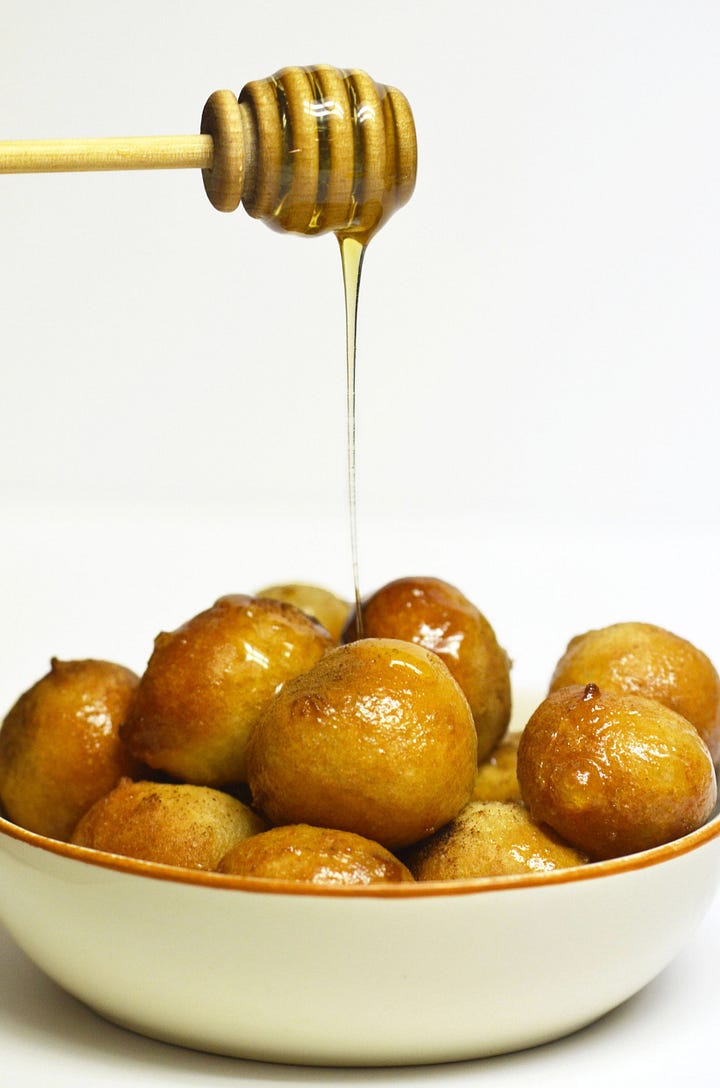Mary Saltas Mannos was 76 years old when I was born, the eldest of my Papou Pete Saltas’ seven siblings and the first Saltas born in the United States in 1915. Aunt Mary’s welcoming spirit and boundless energy were unforgettable. Every visit to her home began with her calling out my name in a joyful, high-pitched “ELENI!!” as she pulled me in for a cheek-pinch and a bear hug that belied her petite frame. She was a mirror of my late Papou Saltas, who passed in 2005—strong, stubborn, and full of warmth. And, oh, how Aunt Mary could cook!
(photos from 2010)



Incredibly, Aunt Mary turned 103 on February 24, 2018. Up until her 100th birthday, she remained remarkably independent, living at home with her son, Father Makarios, a Greek Orthodox monk who now serves at St. Catherine’s Monastery in Mount Sinai, Egypt. Even at her centenarian celebration, she was the one bustling around, serving coffee and making sure everyone had a seat. Her vitality and spirit inspired me, and I have always aspired to be like her. When Aunt Mary was 95, she passed on her loukoumades-making secrets to me—those sticky, golden, honey-soaked donuts that launched my food blogging journey and a decade of culinary discovery.
Loukoumades are a treasured part of our family’s Greek heritage, especially on New Year’s Eve when Aunt Mary hosted the Saltas clan for her famous fried dough. Her method of shaping dough by hand—squeezing it between her thumb and index finger before dropping it into the hot oil—was as much an art as a science, and she made it look effortless. While modern festivals rely on machines to churn out these treats, I stick to Aunt Mary’s hands-on approach, messy as it may be. Now, I’ve carried on her tradition, making loukoumades for my own family and friends to welcome the New Year. It’s a ritual that connects me to my roots, to Aunt Mary’s enduring legacy, and to the sticky, sweet joy of gathering loved ones around the table.


Ingredients
For the Dough:
1 package (2 1/4 tsp) active dry yeast (or 1 1/2 packages for faster rising)
1 1/2 cups warm water (110°F, lukewarm)
3 1/2 to 4 cups all-purpose flour
1/4 cup sugar
1 teaspoon salt
Vegetable or canola oil (for frying)
For the Honey Mixture/Topping:
2 cups honey
1/2 cup water (only if using thick honey)
Ground cinnamon (for garnish)
Sesame seeds or chopped walnuts (optional)
Instructions:
1. In a small bowl, dissolve the yeast in 1 1/2 cups of warm water. Let it sit for 5–10 minutes until it becomes bubbly or foamy. (or follow instructions on your yeast package)
2. In a large mixing bowl, combine 3 1/2 cups of flour, sugar, and salt. Gradually add the yeast mixture to the dry ingredients, stirring with a whisk or wooden spoon. Add 1 cup of additional warm water to form a loose and sticky dough. If the dough is too stiff, add a little more water.
3. If the dough is too wet, add up to 1/2 cup of additional flour, 1 tablespoon at a time.
4. Cover the bowl with plastic wrap and a dish towel. Place it in a warm spot. Allow the dough to rise until it doubles in size (1–2 hours). Look for bubbles on the surface, which indicate readiness.
Prepare for Frying
Gather your tools, you’ll need:
-A large slotted metal spoon for removing fried dough.
-A small glass of vegetable oil for dipping the spoon.
-A tablespoon or small spoon for scooping dough.
-A large plate lined with paper towels for draining excess oil.
-Fill a medium-sized pot about 1/4 full with vegetable oil. Heat to 360°F, using a thermometer to maintain a temperature range of 355–365°F.
Make the Honey Syrup
1. If your honey is thick, combine 2 cups of honey and 1/2 cup of water in a small saucepan. Heat over low heat, stirring gently, until the mixture is warm and well combined.
2. If your honey pours easily, you can skip heating and use it as is.
Fry the Dough Balls
1. When your dough is ready, heat the oil to 360°F. Once it reaches the proper temperature, take a fistful of dough in your hand and gently squeeze it so that a small amount of dough pushes through your thumb and index finger.
2. Dip a spoon in the glass of oil, then use it to scoop the dough from your hand and drop it into the hot oil.
3. Fry 8–10 dough balls at a time, ensuring you don’t overcrowd the pot. Adjust the heat as needed to keep the oil temperature between 355–365°F.
4. Use a slotted spoon to turn the dough balls so they cook evenly. Once they are golden brown, remove them with the slotted spoon and place them on a plate lined with paper towels to drain.
5. Repeat this process until all the dough is fried. If you want to serve in batches (I do this), then coat with honey and toppings to your guests fresh!
To Serve
You have two options:
1. Drizzle Method: Place the fried dough balls on a serving platter. Drizzle them with honey or the warm honey syrup, then sprinkle with ground cinnamon, sesame seeds, or chopped walnuts, if desired.
2. Coating Method: After the fried dough balls have been laid on the paper towel, place the fried dough balls directly into the pot of warm honey syrup, stirring to coat them well. Transfer the coated dough balls to a serving tray, then drizzle with extra honey and sprinkle with cinnamon and toppings of your choice.




Ms. Saltas:
I was looking up alternative loukoumades recipes since our Greek festival is this weekend. I almost fell over when I saw the picture of Fr. Makarios! He served a lot at our church in Missoula and is a truly remarkable person. Your recipe and technique are really appreciated!
Andrew George
I loved watching Aunt Mary make these! She would tell me stories about my Yia Yia Mabel while she would make her loukoumades!